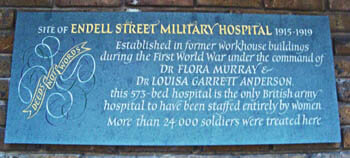Louisa Garrett Anderson (1873-1943) and Flora Murray (1869-1923)
An extraordinary Partnership
by Alison Bailey
Local women made the most extraordinary contributions to WWI. Two of them, Louisa Garrett Anderson and her life partner, Flora Murray, who lived next to Holy Trinity Church, Penn, were both qualified doctors. They trained at the London School of Medicine for Women, founded by Louisa’s mother, Elizabeth Garrett Anderson. They were militant suffragettes in the years leading up to the war with Louisa spending six weeks in Holloway Prison for taking part in a mass window smashing campaign in 1912.
Women’s Hospital Corp

When war was declared in 1914, they laid down their banners and sought to help the Allied war effort. They founded the Women’s Hospital Corps and undeterred by the rebuttal of the Royal Medical Corps they offered their services to the French who were desperate for medical and surgical aid. They had just 12 days to raise the funds, find a staff and purchase the equipment and all the stores which were needed for a military hospital. They then travelled to Paris to open their first unit in the Hôtel Claridge.
Flora Murray wrote in her memoir Women as Army Surgeons “the long years of struggle for the Enfranchisement of Women which had preceded the outbreak of war had done much to educate women in citizenship and in public duty. The militant movement had taught them discipline and organisation: it had shown them new possibilities in themselves and had inspired them with confidence in each other”.
They designed their own practical uniforms and wore the purple, white and green badge of the Women’s Social and Political Union with pride. Despite never having had the opportunity to work with men’s bodies before as women doctors were only permitted to treat women and children, the Women’s Hospital Corps was an immediate success, and the British Army quickly realised their mistake. In 1915 they were asked to establish the Endell Street Military Hospital for the Royal Medical Corps in a former workhouse in Convent Garden. The St Giles Workhouse, as it was known, was supposedly the inspiration for Charles Dickens’ Oliver Twist.
Endell Street Military Hospital

Like the hospital in Paris and a later hospital in Wimereux, the Endell Street Military Hospital was staffed entirely by women, from chief surgeon to orderlies. The hospital became a specialist centre for head injuries and fractures and even published clinical research. It closed in August 1919 having treated 24,000 patients and carried out more than 7,000 operations. It was widely considered the best run hospital of the war and the all-female staff proved what many had before doubted, that women could manage the medical and administrative needs of a hospital just as well as men. Mostly funded by suffrage campaigners, the hospital adopted the suffragette motto ‘Deeds not Words’. When the 1918 Representation of the People Act was passed, giving limited suffrage to women, a purple, white and green flag was raised.
Flora Murray was never recognised as a lieutenant-colonel by the British Army, the rank she was due as Doctor-in-Charge of a military hospital. Nor did chief surgeon Louisa Garrett Anderson achieve any rank. However, they were both made Commanders of the British Empire in 1917.
Suffragettes in Penn
After the war, the couple purchased Paul’s End, a large house close to Holy Trinity Church, Penn. A group of militant, campaigning suffragettes all settled in Penn at this time, presumably after developing deep friendships during the campaign for Votes for Women. These included Princess Sophia Duleep Singh, her sister Catherine, and Muriel Matters. About Muriel – The Muriel Matters Society Inc. Muriel is the first woman to have spoken in the House of Commons after chaining herself to the grille in the Ladies’ Gallery in 1908.
Louisa and Flora probably discovered Penn through their visits to their friends, Zoe Proctor and Dorothea Rock, another same-sex, suffragette couple who had a country house, Shepherd’s Corner in Gregory Road Beaconsfield. Louise met Dorothea and Zoe in Holloway Prison. Dorothea and her sister Madelaine were nicknamed the ‘Smashing Rock Sisters’ by their local press after they were arrested for taking part in the Pankhursts’ window breaking campaign.
Penn was also targeted by suffragette arsonists in 1913 when the organ in Holy Trinity Church was set on fire. It is believed that the church was attacked because of its association with Lord Curzon, the founder of the Anti-Suffrage League. The church contains many memorials to the Curzon family.
Flora continued to practise as a doctor in Penn until her early death from Cancer in 1923. Louisa stayed on, became a Justice of the Peace, secretary of the Penn Conservative Association and chairman of her local League of Nations branch. I wonder if she ever told her follow JPs that she had once spent 6 weeks in prison! She died 20 years after Flora and was buried with her in Holy Trinity’s graveyard. Their memorial stone is engraved “We have been gloriously happy.”
Further reading
Women at War, a celebration of our local suffrage campaigners and their contribution to WWI, Alison Bailey for Amersham Museum
Women as Army Surgeons: Being The History of Womens Hospital Corps 1914-1919, Flora Murray
Sophia: Princess. Suffragette. Revolutionary, Anita Anand
Miss Muriel Matters, the fearless suffragette who fought for equality, Robert Wainwright
Endell Street: The Trailblazing Women Who Ran World War One’s Most Remarkable Military Hospital, Wendy Moore

